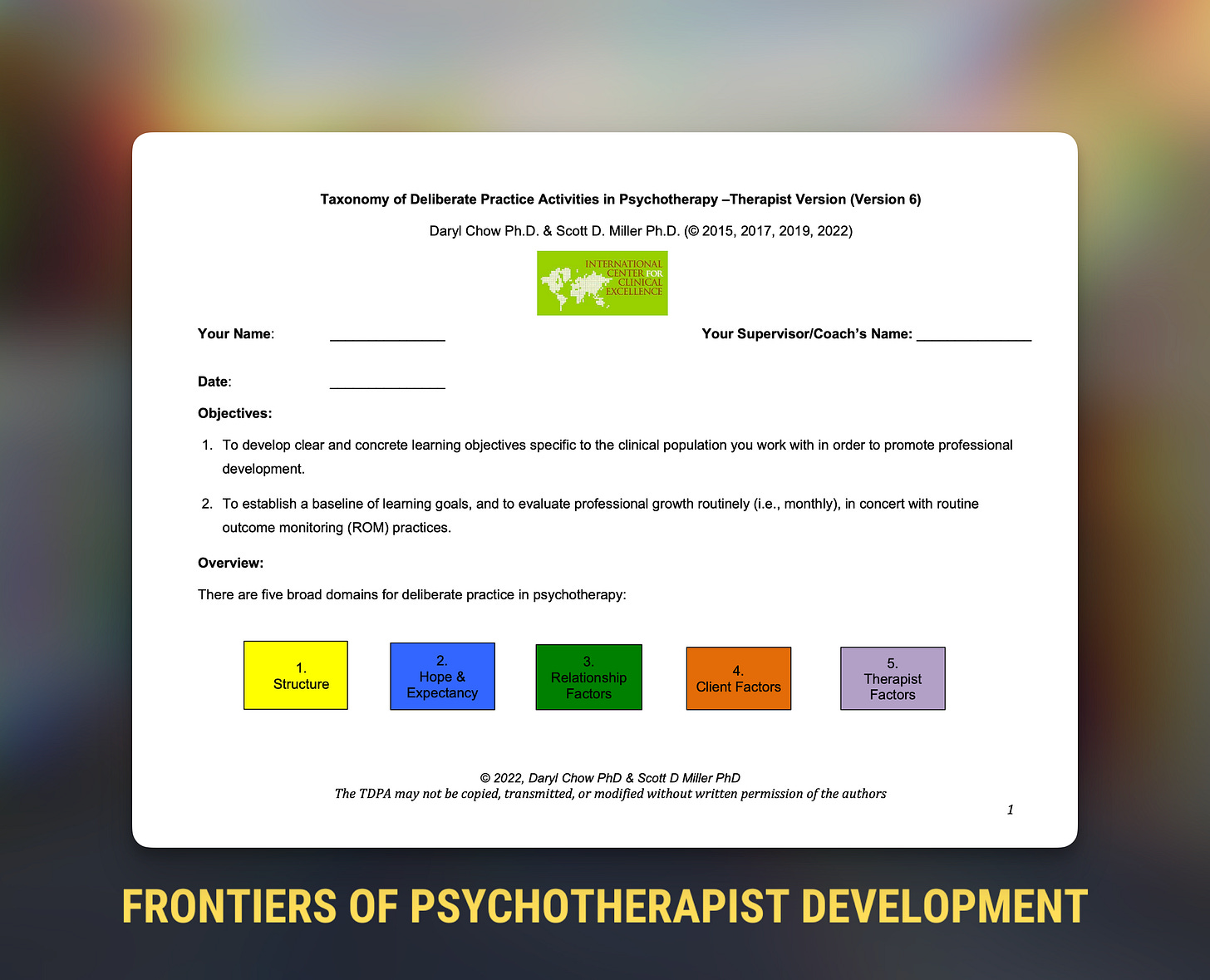The Taxonomy of Deliberate Practice (TDPA) Worksheet... Now Available to Track Over Time. #184 ⭕️
The latest version of the TDPA and a way for you to track your development over time.
Let me get straight to the point.
Here is a worksheet that is going to be a vital piece of your professional development. It’s called the Taxonomy of Deliberate Practice Activities (TDPA) Worksheet (Chow & Miller, 2015, 2017, 2019, 2022).
And we’ve just made a Spreadsheet version of it, so that you can easily eyeball your development and keep track over time.
We have the just updated to the last version, v.6.
What is the Taxonomy of Deliberate Practice Activities (TDPA) Worksheet?
The TDPA is a tool that guides practitioners in identifying areas for improvement in their work. By rating themselves on various aspects of their practice, practitioners can pinpoint specific areas where they need to focus their efforts. The TDPA encourages practitioners to prioritise high-leverage areas that are likely to significantly improve outcomes, even if these areas may not be their current weaknesses.
The TDPA is divided into five main domains:
Structure
Hope & Expectancy
Relationship
Client Factors
Therapist Factors
Each domain is further broken down into specific activities that therapists can rate themselves on a scale of 0 to 10. By identifying the areas where they need the most improvement, therapists can develop learning objectives and create a plan for deliberate practice.
The TDPA also provides space for notes and reflections, which can help therapists track their progress and identify patterns in their practice. By using the TDPA routinely, therapists can identify areas for improvement, develop learning objectives, and create a plan for deliberate practice. This can lead to improved outcomes for their clients.
The best part is, you can enlist your clinical supervisor to help also complete the TDPA. From their perspective, they can offer you insights into seeing what you don’t see.1
In summary, here’s what the TDPA worksheet is aiming at:
Main Objectives:
Determine specific areas for improvement to enhance therapy skills
Take ownership of your professional development
Main Benefits:
Leveraging therapy skills that lead to better client outcomes
Personalised learning objectives for targeted improvement
Tracking development and encouraging sustainable growth
Next week, I’d give you the backstory to the genesis of the TDPA, in-depth insights that we’ve learned from using the TDPA ourselves and with clinicians globally, and how this lead to the workbook, The Field Guide to Better Results.
For now, here’s the download of the TDPA worksheet, as well as access to the GoogleSheet.
(Note: The file is locked; you’d have to make a copy so that you can edit it. Instructions will be sent to you after the button below).
YOUR TURN: If you’ve gone through the TDPA, I would love to learn from your perspective on what it was like for you. Plus, do you see any pitfalls to this worksheet? Stay tuned for next missive, as we will address some of these.
RELATED:
Thank you for reading Frontiers of Psychotherapist Development (FPD) and our weekly newsletter, Frontiers Friday (FF). If you are new here, learn about me, the About Page and our “Grand Plan” overview post.
These posts are meant to be what Lewis Hyde describes as a “Gift.” What this “Gift” concept means is that
Nothing is expected out of you.
I hope you receive it.
I hope this animates and transforms you.
I hope you spread the love to others.
Daryl Chow Ph.D. is the author of The First Kiss, co-author of Better Results, The Write to Recovery, Creating Impact, and the latest book The Field Guide to Better Results.
To be clear, a supervisor must have insights into how you conduct therapy (i.e., listening to your session recordings), coupled with the ability to make sense of the patterns in your aggregated outcomes. Without these, it would be very difficult to have a clear sense of “how you do what you do.”






